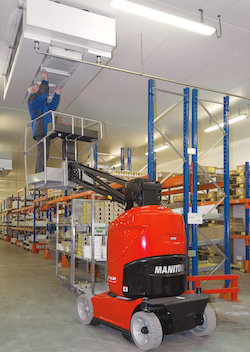Equipment Insight: Indoor MEWPs
Advances in electric models improve worker safety and productivity while opening options for indoor/outdoor jobs.
 |
|
Product Manager |
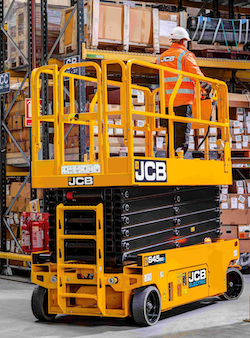 |
|
Contractors like MEWPs because these machines enable them to work faster, more efficiently, safer and with better ergonomics than any other solution. |
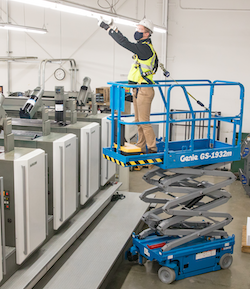 |
|
Micro scissors have been growing in popularity because they meet the needs of a wide range of tasks on job sites where a standard-sized scissor lift may also be considered. Their compact footprint and light weight offer the opportunity to serve job sites where standard-sized scissor lifts won’t work. This expands the opportunity for increased utilization in applications such as data centers, warehouses and industrial or institutional buildings. |
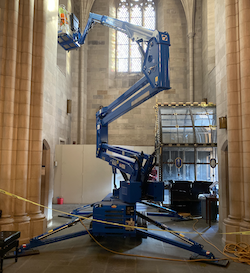 |
|
CTE has some of the smallest footprints in the industry in every size machine it offers. Users can work in small rooms, which has been a huge selling point for customers working in churches. |
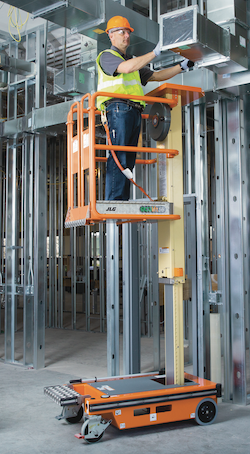 |
|
Demand for indoor MEWPs is hitting a new market inflection point as this type of equipment becomes more widely adopted in applications that traditionally have used ladders or scaffolding. |
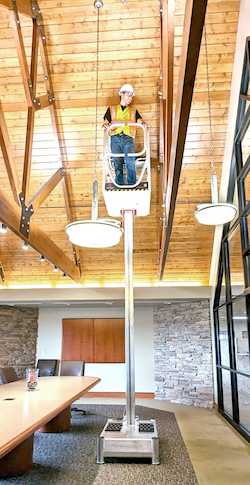 |
|
Indoor mast lifts can make overhead work more productive and safer for workers. |
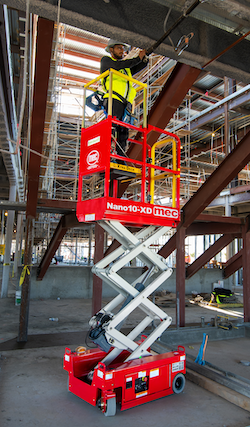 |
|
The 1,235-pound MEC Nano10-XD machine is approved for work on most restricted suspended flooring applications. It provides a huge improvement in safety over ladders and multiples of productivity over push-around machines in a highly efficient all-electric machine package. |
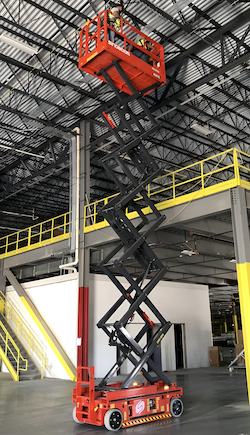 |
|
Sinoboom’s line of electric MEWPs can be switched between indoor and outdoor capabilities. |
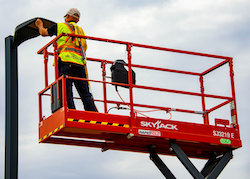 |
|
Skyjack’s unique scissor stack design makes these scissor lifts an ideal choice for a wide range of indoor and outdoor construction, maintenance and industrial applications. |
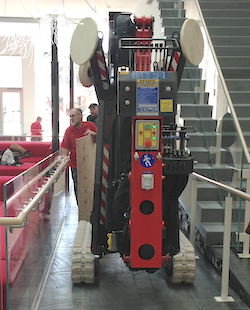 |
|
The slender profile of Tracked Lift models facilitates seamless maneuverability in tight spaces, granting rental centers with a competitive advantage in meeting varied customer demands. |
|
|
| Manufacturers are increasing autonomy and flexibility by adding optional generators or range extenders to these machines to support ancillary applications like welding. This gives the rental centers the opportunity to provide a rental customer with options. |
Versatile, labor saving, safer and ergonomic
Equipment rental centers like MEWPs because these machines are extremely popular with contractors, both residential and commercial. Here are some of the reasons:
Versatility. MEWPs are used in a broad range of industries and construction trades, including painting, plumbing, electrical, carpentry, welding, glazing, insulation, drywall, HVAC and more.
Labor savings. In the trades, labor is often one of the biggest costs. An MEWP can be set up and working over a large area much faster than scaffolding that must be erected and dismantled; and the maneuverability of MEWPs allows workers to travel from point to point without having to climb a scaffolding or ladder.
Safety. OSHA reports that slips and falls are the No. 1 source of injuries on construction sites. Surrounded by guard rails on all four sides, workers can operate as safely as they would be on the ground. Fall protection devices can also be secured to the guard rails.
Ergonomics. Standing on a ladder or stooping, reaching and twisting around on a fixed platform can put strain on the body and slow work. MEWP controls enable workers to fine-tune their height and angle to the work, so all work is done with a minimum of strain. Pipe cradles, glazing kits and other material-handling accessories ensure that heavy lifting isn’t completed from an awkward or dangerous angle. Tool trays allow workers to do their jobs without having to wear heavy and cumbersome tool belts.
Equipment rental centers contemplating the acquisition of new aerial equipment machines must navigate several crucial considerations to ensure compliance, safety and operational efficiency. Paramount among these is adherence to ANSI standards, which are frequently updated to enhance on-site safety through new compliance requirements. Keeping pace with these standards requires ongoing vigilance and a proactive approach to integrating advanced safety measures into their equipment offerings.
Additionally, the diverse functionalities, parts and service schedules associated with different brands and models means comprehensive training is needed for sales and service personnel. This training ensures that staff can provide informed, reliable support and advice to customers, thereby reinforcing safety and operational integrity.
Another significant consideration is the availability of original equipment manufacturer (OEM) parts, which is critical for maintaining the reliability and performance of key components. A well-managed parts inventory by the OEM is essential for prompt and effective maintenance and repair services, further underlining the importance of selecting equipment from manufacturers with reliable parts supply chains.
Together, these considerations form a complex landscape that equipment rental centers must navigate to ensure their aerial equipment is safe, compliant and capable of meeting diverse client needs.
Rental makes the most sense for most contractors, which is a point rental centers should emphasize to their customers. In most cases, contractors rent rather than purchase MEWPs because those portions of the job that require MEWPs comprise a small fraction of the time and cost of a construction project.
By renting these machines on a project-by-project basis, the contractor is relieved of the burden of ownership including maintenance, storage and depreciation. In addition, a contractor who rents an MEWP is more likely to get a model with the latest technology, capabilities and safety features.
 |
|
Founder |
Versatile units can mean longer time on-rent
Additional safety features, along with upgraded automation and user-friendly controls, continue to enhance the value of these highly adaptable, powerfully useful pieces of heavy equipment.
The simplicity of use, versatility and greater degrees of safety that define new MEWPs offered by CMC are standout features that attract rental clients. Spider-style MEWPs provide the ability to use the same machine across a broad spectrum of applications indoors and outdoors.
Rental customers can leverage the potential of using just one machine capable of setting up on uneven surfaces and operating outdoors, and then fitting through a doorway to enter interior areas to reduce the volume of equipment changeovers, deliveries and retraining. This results in longer time on-rent.
Wireless radio remote controls, automatic return home/park feature found on most CMC models and automatic self-leveling also translate to a safer work environment.
The CMC F-Series of tracked aerial lifts is ideal for many indoor jobs. Featuring a working height ranging from 42 to 60 feet, these lifts provide unsurpassed levels of access to interiors of churches with suspended floors or theaters with sloped floors without having to remove bolted seating. Moreover, when outfitted with a 120-volt plug-in electrical motor or Li-ion batteries, fast-operating CMC lifts can get the job done quickly and efficiently without exhaust emissions. Lightweight and carrying a low ground pressure, CMC F-Series lifts can safely operate on delicate flooring surfaces such as finished hardwood, tile or marble, making them perfectly suited for work within museums or gymnasiums. Their working height and lateral reach make them great glass-cleaning solutions outside and inside atriums.
Conscientious rental centers are concerned about the level of customer service, reliability, safety, ease of operation and reputation of indoor MEWP providers. Options that All Access Equipment offer satisfy all these concerns. All CMC F-Series models are extensively product-tested and have proven to be reliable and easy to maintain. Rental house technicians can also rest assured that the technical support team is only a call away should any problem or question arise. All F-Series units are delivered with detailed how-to operation video playlists, which rental centers can share with their customers. Quick-use guides and other informational and support materials are also available.
Highlighting the many benefits of renting or leasing these models attracts customers with minimal effort. The ROI of indoor MEWPs is typically both significant and swiftly felt by rental. These lifts are all-in-one solutions for outdoor landscaping, indoor maintenance and outdoor and indoor construction projects. Instead of relying on a fleet of scissor and boom lifts to satisfy the needs of renters, nearly all MEWP job descriptions can be accomplished with the CMC F-Series lifts. Once a potential customer is aware of the myriad of benefits and applications of CMC indoor MEWPs, they’re likely to realize that the product is precisely what they need.
 |
|
Founder |
New indoor MEWPs elevate rental center success
The latest advances in indoor MEWPs bring a host of attractions and benefits for rental centers and their customers. Newer models are often sleeker in their design and offer improved usability and safety, making them more appealing to a wider range of users.
The most significant advantage of investing in indoor MEWPs is the transition from hydraulic-driven systems to electrically powered mechanisms. This shift addresses the long-standing concern of hydraulic fluid spilling on indoor job sites, offering a safer and cleaner alternative. The electric drive also reduces the need for fuel, saving the rental customer money in the long run.
However, investing in indoor MEWP models isn’t always going to be the best solution for rental companies. Alongside the benefits come notable concerns that rental centers must navigate.
The substantial cost associated with acquiring these newer, advanced units can be daunting, particularly because indoor lift equipment is highly specialized, so it may not have a high utilization rate.
There is also a legitimate worry about the availability of qualified technicians capable of servicing these newer machines. Electric equipment requires an in-depth understanding of electrical functionalities, circuitry and high-voltage systems. Understanding how the wiring intertwines is more advanced than hydraulic systems. While there are courses that teach technicians how to work on these new models, it requires investing in training, which can be costly.
There are compelling reasons for rental centers to consider investing in new indoor MEWP models. While the upfront costs may be high, the long-term benefits in terms of operational efficiency and customer satisfaction can outweigh these initial expenses.
As more manufacturers and suppliers move away from gas-powered equipment, rental centers will need to increasingly invest in electric equipment. By embracing these advances, rental centers can position themselves as leaders in the industry.
Navigating the transition to new indoor MEWP models requires careful planning and strategic decision-making. Rental centers must assess market demand and evaluate the feasibility of incorporating these advanced units into their fleets.
Investing in training and maintenance programs is essential to ensure that staff members are equipped with the necessary skills to handle electrically powered systems effectively.
By taking these steps, rental centers can reduce any risks and maximize the potential of adopting new indoor MEWP models into their equipment fleets. There are new models hitting the market, like the MEC 4069ERT and 3369ERT, that indicate the development of electric, rough-terrain scissor lifts will continue and may not be as specialized as once thought.
While there are challenges associated with the adoption of new indoor MEWP models, the benefits far outweigh the drawbacks for equipment rental centers. By leveraging the advantages of sleeker designs, improved usability and cleaner operation, rental centers can enhance their competitiveness and meet the evolving needs of their customers. With careful planning and investment in training and maintenance, rental centers can and should capitalize on the opportunities presented by these innovative advances in indoor MEWPs.
 |
|
Senior Global |
Micro scissor lifts gaining popularity
Micro scissors have been growing in popularity because they meet the needs of a wide range of tasks on job sites where a standard-sized scissor lift may also be considered. Their compact footprint and light weight offer the opportunity to serve job sites where standard-sized scissor lifts won’t work. This expands the opportunity for increased utilization in applications such as data centers, warehouses and industrial or institutional buildings.
In the micro scissor category, Genie offers the GS-1932m, which has an indoor working height of 24 feet 2 inches, and the GS-1432m, with an indoor working height of 20 feet 1 inch.
As technology continues to evolve, the demand for service technicians with new skills will present continuing labor challenges. To help fill that skills gap, equipment owners in many cases are turning to OEMs for product support, training and maintenance. To meet that need, Genie offers a range of aftermarket support options. By investing in quality, low-maintenance micro scissor lift models, rental companies will spend less time on maintenance and save money over the life of the machine while also increasing uptime.
Total cost of ownership also includes residual value. By selecting a brand with a high residual value, rental centers maximize the total fleet value. As micro scissor lifts have grown in popularity, there has also been an increased interest in productivity accessories like those available for standard-sized scissor lifts. A good example is the Genie Lift Tools Access Deck. HVAC, electrical, lighting and plumbing tasks might require work in space-restricted areas and the Access Deck provides a secondary work surface, elevating operators 22 inches above the platform floor. A kit that enables Genie’s standard Access Deck to fit Genie micro scissors is now available. The Access Deck can be an additional revenue-generating item for rental companies to offer customers as well.
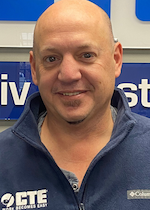 |
|
Dealer and Training Manager |
More operator training now required
The greatest benefit to new indoor MEWPs, specifically the CTE Traccess, is compactness. Most spider lifts can fit through a standard door but require the door to be taken off to avoid damage. Being able to fit through a standard doorway without taking the door off its hinges is crucial to working indoors. All CTE lifts are equipped with retractable tracks allowing even them to become about 31 inches wide in travel mode.
CTE has some of the smallest footprints in the industry in every size machine it offers. Users can work in small rooms, which has been a selling point for customers working in churches. A battery-powered or hybrid machine that recharges during use is also important.
Ease of operation and training should be the greatest concern for any rental company. The CTE Traccess 270/88 has a display panel that indicates which functions are enabled, which reduces the time it takes for a new operator get familiar with the controls. It shows him/her what steps can be taken next.
Another concern rental houses may have is that the ANSI standards for training have become more formalized. Operators are now required to be trained beyond mere familiarization of the controls. Rental equipment centers need to be aware of these changes and their responsibilities. While model price will always be a business concern, ease of operation and training as well as versatility of the lift should be considered.
The indoor aerial lift market is highly specialized and often a tracked lift is the only lift capable of reaching the task. Rental companies should charge a premium for the use of a premium lift. Re-renting from select CTE dealers is an option; 40 percent of total CTE Traccess rentals are for re-rent.
 |
|
Product Manager |
MEWPs replacing scaffold, ladder use
Demand for indoor MEWPs is hitting a new market inflection point as this type of equipment becomes more widely adopted in applications that traditionally have used ladders or scaffolding. Indoor construction and maintenance tasks often need to be done in areas that are difficult to navigate with larger, heavier machines, including traditional slab scissor lifts. Compact scissor lifts, low-level access lifts and vertical mast lifts are being rented more frequently for these applications for contractors to meet core job site requirements, such as:
- Smaller footprint to fit smaller spaces
- Lighter weight for use on different types of sensitive surfaces, like finished flooring
- Short or zero turning radius for enhanced maneuverability
- Ability to fit in freight elevators
These types of indoor MEWPs allow renters to access high-reaching or overhead tasks in hard-to-reach places like areas obstructed by infrastructure, tight racking, ducts, pipes, ceiling tiles or joists. Some vertical mast lifts have up-and-over capabilities, which means renters can easily maneuver around fixed obstacles at height to work.
These machines weigh less and are so compact that once the work is done, they can be stored in small spaces.
Indoor MEWPs are also gaining favor among companies focused on eco-friendly solutions and sustainability. For example, human- and battery-powered lifts run quieter and eliminate or reduce emissions altogether, so they can be used in clean rooms, data centers, hospitals, schools, libraries and office buildings.
Indoor MEWPs aren’t one-size-fits-all. There are many styles and options from which to choose based on the size of the product and environmental sensitives. Human-powered lifts are lighter in weight and quieter than their battery-powered counterparts. While still small, battery-powered units tend to have a slightly larger footprint, are heavier and have a higher platform capacity, allowing renters to bring more tools and materials with them to the work area, reducing the number of times they need to ascend/descend during the workday.
The variety in these types of lifts means that equipment rental centers need to help their customers to choose the right model based on the job.
Ladders and scaffolding have been around for a long time, but the increasing market demand for indoor MEWP equipment is being driven by safety, productivity and ergonomics. These factors are becoming increasingly more important with the rapid rise of labor rates, workers’ compensation and an aging workforce.
As rental customers consider using indoor MEWPs as an alternative to more traditional ways of completing work at height, rental centers need to be prepared to meet that demand. These machines are lightweight and compact so they can be pushed into place or between work areas while requiring minimal storage space. They are ideal for renters to use in a wide variety of applications. Their popularity continues to grow thanks to their ability to be used on sensitive flooring and fit into and moved between floors in elevators for ongoing facility maintenance, from airports and data centers to high-rise buildings and just about anything in between. Because of their portability, indoor MEWPs can be lowered and moved from one location to another to perform multiple tasks throughout a facility in less time.
Additionally, because of their size and weight, they are also well-suited for fit-out and finish work on construction sites, such as painting, installing fire alarm or sprinkler systems, putting in or replacing lighting and dropping in ceiling tiles. Other common applications for indoor MEWPs include refitting retail displays and updating seasonal décor, as well as maintaining production equipment in manufacturing environments.
 |
|
President |
Telematics key to fleet management
As a rental house, telematics have been the most significant benefit in newer equipment. The ability to remotely check on usage and charging habits and to be able to diagnose a machine from a distance can often save a service call.
Like most of the updates made on equipment, there is a learning curve for the customer. Customers are used to having someone physically come out. They don’t necessarily want to have to take any steps in helping to diagnose the issue. They want to make a phone call and they want someone to come out in person.
The location-tracking piece of telematics has been a benefit for Lizzy Lift because the specialty equipment it offers is sent all over the country. The ability to track and monitor haulers to see where equipment is at any given moment is very helpful. It has also been helpful for drivers to locate equipment more quickly on the job site.
The nature of Lizzy Lifts’ business is that the fleet is often far away from our location. As telematics to continue to improve, rental centers will be better able to manage its fleet.
The new technology and safety features have created a steep and rapidly expanding learning curve for technicians and customers alike. Keeping teams updated on all the new technologies is challenging but essential.
Quality control with all the changes is also a concern as there has been a significant increase in warranty issues. The new features in equipment have been happening quickly while big strides are making equipment safer. However, all the safety features have been increasing service issues and costs. There have been many issues around load-sensing components. Machines often need to be recalibrated and slight movement can cause them to code out, which often ends up in a service call. This is across multiple brands from the top of the line to the newer machines on the market.
Internally, the costs are significant. Brand-specific diagnostic tools or software are needed to test load sensors. The replacement and maintenance cost of these devices is very expensive.
From the customers perspective, the ones who have been using MEWPs over the years are not used to the sensitivity of the load sensors. They are now having to be more aware of how heavy their operators are and how many or how few tools they can put in their basket. It’s good; it’s safer; but it is a learning curve for the customer.
It’s beneficial to have more options in choosing equipment manufacturers. The ability to buy less expensive equipment from the newer brands can help increase ROI. Telematics can bring savings in immediate service needs and keep equipment functioning well long-term. They also can save time and money in helping drivers locate equipment more quickly and in theft prevention.
There are growing pains both financially and otherwise and all hope this is an adjustment period that passes quickly. Over time, customers’ and technicians’ familiarization with the newer features will improve, tools needed for diagnostics will have been bought and paid for and manufacturers will work out the glitches. Hopefully, the extra costs will decrease. In the meantime, the demand for rental equipment is still growing. Rental rates need to be in line with creating a strong ROI. Buying right is essential, so know your market. Train your team and your customer base. Understand your clients’ needs and stay on top of new construction and major infrastructure projects being planned.
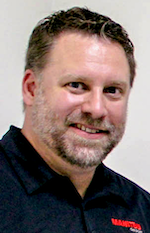 |
|
Product Marketing Manager, MEWPs/Forklifts |
Electric models gain in performance and efficiency
The updated ranges of indoor MEWPs during the last five years have seen huge improvements in efficiencies with battery and hydraulic performance, resulting in smoother and faster access which translates into time savings.
Electric MEWPs and forklifts were some of the first mass-produced, functional and viable electric equipment in the industry. Now that more automotive, industrial and other consumer electric products have come to market we have seen improvements in component quality, performance matching and more suppliers contributing to many efficiency and durability improvements.
Electrified MEWPs are coming out in the size and type of MEWPs not originally designed for indoor use. They are capable of working indoors and the range of capabilities possible with those machines have grown. For instance, an all-terrain MEWP may have much more reach, a larger platform, four-wheel steer and more capacity in an indoor application vs. a more traditional electrified industrial MEWP.
The larger, more fully featured MEWPs are now able to work indoors, which opens a new range of capabilities and features to add to each machine such as welding kits, basket kits, glazer kits and more.
End users are still limited by the size of the entryway a machine can get into, but large warehouse builds and industrial construction sites can support larger MEWPs working within their structures. Having more products capable of safely working indoors presents more versatility for rental centers to apply inventory to other applications.
Access to suitable charging equipment is always top of mind. Electric MEWPs carry onboard chargers that can be easily plugged into standard 110-volt outlets onsite. During operation, a typical application does not induce high system loads, unlike a production-level machine that is under constant load. As a result, most models can work a full day under a full charge and then recharged overnight if there is a suitable access to power on that site. There is less of a chance with MEWPs for a battery to be used up midway through the day and then leaving the operator without a machine while it recharges.
With more electrified machines entering rental fleets, there are obvious concerns around the differing service requirements around battery-powered equipment vs. a diesel or gas engine. Service is easier on these machines due to the elimination of many of the fluids and other elements required with diesel or gas engines.
With machines that will see higher loads and onsite usage, manufacturers are increasing autonomy and flexibility by adding optional generators or range extenders to these machines to support ancillary applications like welding. This gives the rental centers the opportunity to provide a rental customer with options. Operators can choose the rented machine’s flexibility level for sites where there is not yet access to electricity.
Older machines with older charge and battery technology were commonly subject to charge memory that could severely impact the long-term performance of the onboard batteries. As with electric component improvements, battery technology has made large leaps. For example, Manitou uses higher-density traction batteries in its MEWP machines, which bring key characteristics like extended working hours, fast charging, improved lifespan and resistance to strong vibration. On average, a well-maintained traction battery can last between five and seven years with many seeing even longer life. This longer life and lower maintenance costs contributes to lower total cost of ownership (TCO) of Manitou MEWPs.
In the long term, total cost of ownership (TCO) is less than that of an engine-driven model, because you’re eliminating some of those fluids and service items. Overall, a machine equipped with an electric drive system, electric motors and controllers combined with fewer moving parts and proven hydraulic components requires significantly less routine maintenance, service and wear parts, resulting in up to 20 percent lower TCO.
If a rental center is only going to keep a machine for a few years and then cycle it out, it may be hard to realize that return on investment, but it’s also important to know these machines will retain value on the secondary market, so rental centers can invest in these machines knowing they’ll be easy to own and operate, without worrying about being left sunk with depreciation.
The addition of the new indoor or even an indoor-capable rough-terrain MEWP models in the rental center’s fleet can also expand their ability to reach new customers and markets, leading to growth in their customer base. Rationalizing the purchase using the technology benefits and versatility found in the MEWPs of today can positively impact the bottom line while almost creating no disturbance in the way the business is run. Everyone wins in that scenario.
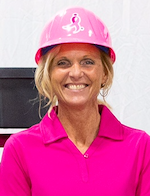 |
|
Owner |
Micro lifts can replace ladders on job sites
Low Level Lifts representatives like to use the MEWP acronym with a twist on a new product category, which are Micro Elevating Work Platforms. Several of these lifts can be loaded into a box truck for delivery.
Low-level access is a market largely unsupported in North America with great growth potential. They are a booming business in countries with ladder use restrictions. Best practices and declarations of “ladders last” in the United States is growing on commercial construction sites. Providing safe and efficient alternatives to ladder use will differentiate your rental center business from your competition.
Rental centers accustomed to walk-in traffic will be faced with logistics issues. Conversely, high-rise construction contractors might require many micro elevating work platforms. An investment into the tooling required for maintenance and inspection is imperative, but the investment is quickly to recouped.
Rental centers can rationalize adding micro elevating platforms into their fleet by starting at scale and find a core customer. First, consider a small group of customers who are early adopters of new equipment types. For the market to grow, others need to witness the efficiencies these lifts provide. Additionally, make sure the application is correct. These lifts replace ladders, but they do not replace large scissors and booms that are required to be constantly moved.
 |
|
Product Director |
Safety culture influencing work-at-height
Rental customers expect a wider selection of more modern equipment when they come shopping at today’s rental centers. Many times, they have their own fleet, but it might be out of date or lack the capability they need or want, so they come to a rental center for help. Sometimes they don’t even know what they need and they show up seeking expertise because they trust professionals at the rental center.
Successful and responsible rental companies know this and care deeply about providing the best solutions to their customers. The most important thing rental center pros can do is to reinforce their desire to keep their people safe, comfortable and productive.
Having a comprehensive selection of state-of-the-art MEWPs and being well versed in their features sets a rental center apart from those companies that are lazy or outdated and just want to take a rental order.
As the safety culture continues to grow, so does the recognition of many work-at-height vulnerabilities. This is most true on the lower height applications that still have significant risk, but where step ladders and extension ladders are predominantly used. There are now several MEWP manufacturers that have added lower-height lifts to address this growing opportunity and this trend will certainly become a rapid growth area for units sold in the next five to 10 years.
Good rental centers are always concerned about uptime and utilization and want to offer highly useful products that help get jobs done safely and quickly. The challenge, though, is customers seem to always want more features. With this sophistication comes reliability and complexity concerns. The top MEWP manufacturers strike the correct balance between features and complexity, but there is plenty of gray area from which to choose, so in the end a rental center has to choose the products that are right for its business.
Every now and then, though, there are diamonds in the rough and sometimes less is more in the way of technology. Make sure you deeply explore both ends of the spectrum, but don’t be surprised if you find some very simple and reliable MEWP solutions, especially in the lower height models.
The fact of life of the rental business is it requires continual investment to stay relevant and valuable. My advice is not to try and cherry-pick products based on ROI or transactional revenue, but instead choose to serve a specific market with a full line of equipment. For instance, be the rental center that offers the most comprehensive fleet of MEWP solutions for indoor service and maintenance contractors on jobs from zero to 60 feet. Those customers learn they can come rely on this focused rental center because it will have what they need. This may result in lower revenue on some rentals, but the ROI may be very high.
Rental centers can’t be great at everything, so it’s important to be selective. Take a hard look and don’t miss the immediate opportunity to grab hold of the rapidly growing safety culture and the many new indoor MEWPS, from the big and sophisticated to the small and simple.
|
Vice President, Engineering |
Lighter models work in restricted flooring applications
The 1,235-pound weight of the MEC Nano10-XD machine is approved for work on the most restricted suspended flooring applications. This applies to both new construction and work in older buildings that previously required the use of ladders or push-around machines only. The very lightweight machine provides a huge improvement in safety over ladders and multiples of productivity over push-around machines in a highly efficient all-electric machine package.
Inflationary pressures have pushed up manufactured costs, but rental rates have not increased proportionately. This puts a squeeze on all involved and the successful ones will be those who add value that is recognized by the end user through solving a problem smarter than anyone else.
AGM batteries are the single most consistent predictor of a low total cost of ownership. Features that both di?erentiate and are valued by customers will earn a higher rental rate. MEC offers its patented LCS Leak Containment System which is very popular because it eliminates the headache of diapers to mitigate oil leaks. The patent-pending Xtra Deck is also a popular feature that solves safe access to con?ned overhead areas.
 |
|
CEO |
Indoor/outdoor units offer better utilization
Sinoboom products are designed with both indoor and outdoor dual-use applications in mind. The entire range of Sinoboom slab scissors, electric rough-terrain large scissors and electric booms feature a toggle switch that allows the user to switch between indoor or outdoor applications.
Rental companies, regardless of their size, often encounter diverse job requirements spanning indoor and outdoor settings. By investing in dual-use MEWPs, rental centers can streamline fleet management and enhance asset utilization. This adaptability ensures that rental companies can efficiently meet the dynamic needs of their clients across various job sites.
Indoor MEWPs offer emissions-free applications through electrification, lightweight design for accessing higher floors with ease and a compact size that enables seamless entry through standard doors and elevators. This optimizes efficiency and flexibility in various indoor settings.
Given that certain jobs require specific applications, most rental companies might face challenges in achieving a fleet acquisition mix between indoor-only MEWP models vs. outdoor models.
Unless a rental store chooses to focus on serving a certain segment of the market only, it will be a tough call when it comes to purchasing MEWPs as decisions will have to be made about the mix of models required.
New ANSI or OSHA standard defines indoor applications as those with zero wind speed within closed facilities. Even in covered workshops or job sites, the presence of an open door or window reclassifies the area as an outdoor application. Therefore, strict closure of job sites may be necessary for optimal utilization of indoor-only products.
This is why engineers at Sinoboom believe in delivering solutions that have both indoor and outdoor functions.
Aside from its vertical mast lifts (VML) series dedicated solely to indoor use, Sinoboom’s full ranges of products are designed for both indoor and outdoor applications. They offer dual functionality, ensuring versatility and efficiency across indoor and outdoor work.
Sinoboom’s full electric-powered MEWPs are gaining recognition as best-in-class in terms or product solutions. Sinoboom’s telescopic electric powered booms with up to 91-foot working platform height have performed flawlessly in tests that measure operational cycle times. They also have fast charge times.
When rationalizing the purchase of indoor models, aside from ROI, numerous factors come into play. These include the weight of the MEWP relative to floor loading at the job site, the necessity for a compact size to navigate through tight spaces like warehousing racks, and the overall height compatibility with door frames and elevator weight loading.
Additionally, considerations extend to mezzanine floor loading, charging availability and the time required for charging.
Special attention is warranted for electromagnetic shielding requirements and potential explosive-proof prerequisites, particularly in sensitive environments such as energy plants.
For cold storage applications, the MEWP’s suitability for freezer conditions must also be ensured. Moreover, assessments of overhead beam density within buildings may dictate the need for additional overhead sensor-based or anti-crush protection. Increasingly, there have been special job applications like wafer/circuit manufacturing, data centers, food-processing plants and other facilities that require 100 percent all-electric MEWPs. This holistic approach to procurement ensures optimal performance and safety across diverse indoor environments.
 |
|
Vice President, Marketing |
Users eyeing sustainability
MEWPs in general are useful, safe and efficient pieces of equipment that prove practical and convenient in a variety of indoor applications. New indoor MEWPs, like Skyjack’s new E-Drive line, offer meaningful improvements in terms of uptime and sustainability.
Skyjack’s new electric scissor lifts are designed with an AC drive system that gives users more: more runtime per charge, more profit from lower maintenance costs, more resale value and more return on investment. E-Drive models offer exceptional maneuverability and Skyjack’s unique scissor stack design makes these scissor lifts an ideal choice for a wide range of indoor and outdoor construction, maintenance and industrial applications.
Accessibility is important for indoor applications and Skyjack DC scissor lifts are ideal for work where accuracy and precision turns around sensitive material is critical. Strategic accessories and design features benefit indoor MEWP use specifically. For example, the anti-slip checker plate floor on Skyjack DC scissor lifts incorporates a manually operated roll-out extension deck, which increases work area and provides up-and-over capabilities in tighter areas.
On Skyjack E-Drive scissors, low gross vehicle weight and wide non-marking tires provide low ground pressure to help protect finished flooring, while a 60 percent reduction in hydraulic connections and optional Ecotray leak containment further protects indoor flooring by reducing leak potential.
As productivity and efficiency needs increase, low-level and indoor access applications demand several competing design requirements that are essential to customer acceptance. For example, low gross vehicle weight is crucial, while also providing the performance and productivity expected of a slab scissor lift including higher capacities, two-person occupancy (indoor) and the ability to drive from one location to another while the platform is raised. One solution is Skyjack’s new micro scissor line in the SJ3213 micro and SJ3219 micro. Available in North America, the SJ3213 micro and SJ3219 micro remain simply reliable, combining low cost of ownership with Skyjack’s renowned product support. Fully proportional drive and lift controls offer superior drive with more efficiency, controllability and improved torque, while a variable-speed brushless AC electric front-wheel drive provides exceptional duty cycles. The newest micros have been designed to fit most passenger-style elevators and work in environments where space is at a premium while still providing a substantial work area.
The SJ3213 and SJ3219 micros were designed with maximum uptime and low cost of ownership to address the needs of rental centers as they make informed purchasing decisions. The new micros offer more return on investment with maintenance-free brushless AC electric drive motors and more runtime per charge with less power consumption and lower battery maintenance. To facilitate ease of maintenance, all major service points are easily accessible, enabling straightforward troubleshooting and repairs.
Rental companies and major contractors face increasing demands for sustainability information as the need for improved duty cycles and a more environmentally sustainable product is steadily increasing. This need has propelled the development of E-Drive that Skyjack now offers across its electric scissor range. Skyjack has also introduced its Eco mark to support customers by providing products that deliver benefits in environmental performance and long-term sustainability. Skyjack’s E-Drive scissors Eco benefits include:
- 16 percent operational carbon saving compared to previous model
- Up to 20 percent improvement in duty cycle over equivalent hydraulic drive machine
- Zero emissions
- 90 percent recyclable (by weight)
- Optional Ecotray leak containment
- Approved for use with biodegradable hydraulic oil
- Telematics for remote diagnostics, reducing site visits and operational footprint.
 |
|
CEO |
Tracked lifts offer versatility
Tracked Lifts models stand out as a particularly attractive option for rental centers, especially for indoor applications and beyond. These MEWPs offer unparalleled versatility, tailored to suit a variety of project requirements.
Whether it’s Li-ion power technology ensuring prolonged work hours without emissions or the diverse power options available, Tracked Lifts cater to a wide range of operational needs. Their lightweight construction, complemented by non-marking tracks, preserves delicate surfaces, making them an indispensable machine for indoor projects. Notably, the ingeniously engineered weight distribution on the outriggers ensures a low ground pressure, underscoring their prowess in navigating delicate surfaces with minimal impact.
Additionally, the slender profile of Tracked Lift models facilitates seamless maneuverability in tight spaces, granting rental centers with a competitive advantage in meeting varied customer demands.
Despite their allure, concerns linger among equipment rental centers regarding the maintenance and operational viability of tracked spider lifts. Chief among these worries is the perceived challenge of maintenance, particularly the complexity of servicing these machines.
However, Tracked Lifts engineers have mitigated these apprehensions by ensuring simplicity in design and utilizing trusted components from brands such as Kubota, Honda and Scanreco. Post-sale comprehensive support services, including over-the-phone troubleshooting, extensive spare parts inventory on U.S. soil and field service technicians underscore Tracked Lifts’ commitment to seamless maintenance, easing the burden on rental centers. The reliability and user-friendliness of Tracked Lifts make them a preferred choice for rental centers seeking hassle-free operations.
Tracked Lifts offer significant ROI potential for rental centers for both indoor and outdoor applications alike. Equipped with features like auto-leveling of outriggers and wireless remote operation, these machines enhance operational efficiency and safety, making them user-friendly. Its ability to access both confined indoor spaces and challenging outdoor terrain expands job opportunities, driving increased utilization and profitability for rental centers. These lifts provide rental centers with a competitive advantage in meeting customer demands compared to their wheeled counterparts. Leveraging outriggers for stability, they access challenging heights with minimal footprint, increasing rental frequency and job opportunities, thereby boosting revenue streams.
The evolution of Tracked Lifts in indoor rental fleets represents a paradigm shift in the equipment rental industry, offering unprecedented benefits tempered by manageable concerns. As rental centers navigate this transformative landscape, a nuanced understanding of attractions, concerns and ROI considerations will undoubtedly guide informed decisions, unlocking the full potential of these innovative machines.
This story originally appeared in the May-June 2024 issue of Pro Contractor Rentals magazine. ©2024 Urbain Communications LLC. All rights reserved.


